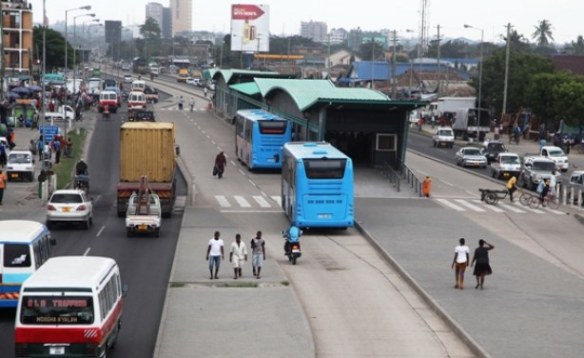NPI: What is your background? How did you come to work for ITDP?
Cities today face the critical task of reducing inequality while also minimizing their contribution to global climate change. My interest in tackling these twin challenges first led me to ITDP in 2003, when I worked on an assessment of the environmental impacts of the proposed bus rapid transit (BRT) system in Cape Town, South Africa. I later joined ITDP’s India office at the end of 2007. We helped implement India’s first high quality BRT system, known as Janmarg, in the city of Ahmedabad, and went on to work with a number of other Indian cities to create better public transport, usable footpaths, and transit-oriented development policies. I am now heading ITDP’s Nairobi office where we work to ensure a sustainable, equitable future for African cities.
NPI: Can you describe some of your work on transportation in Nairobi? What are the challenges and also opportunities?
With a population approaching 4 million people, Nairobi is in urgent need of a safe, modern, and efficient public transport system. The most viable way to bring high quality service to the majority of Nairobi residents is to develop a bus rapid transit (BRT) system along the city’s main roads. A BRT system would offer faster travel in dedicated bus lanes, stepless boarding from central stations, and convenient smart-card ticketing. The timely deployment of BRT also has tremendous potential to transform the city’s matatu industry, helping to grow the mode share of public transport in the city and improving working conditions for operators.
Over the past several years, ITDP has been providing support to national and local government agencies on the development of an integrated BRT network in the metropolitan region. As part of these efforts, ITDP prepared a service plan for BRT Line 1, which runs from James Gichuru to Jomo Kenyatta International Airport on the A104. We are now working to ensure that the service plan’s findings are used to shape the infrastructure designs along the corridor and that the designs for Line 1 mesh with the plans for other BRT corridors in the city.

Dar es Salaam recently launched a Bus Rapid Transit System
NPI: Setting up a new program and office must be exciting! As Africa Program Director, what is your vision for work moving forward? Who would you like to partner with and what would you like to accomplish in the coming years?
As we begin to deepen our presence in the region, we look forward to expanding our activities in Kenya and launching work in new cities. We welcome partnerships with like-minded organizations, individuals, and cities. Our vision is one where cities put people before cars, one where residents, workers, and visitors, both young and old, can safely walk or cycle to their daily activities. We also want to create more affordable cities, where jobs and services are a short bus or BRT ride away, allowing residents to put money that otherwise would have been spent on driving to more productive uses. These are the kinds of cities that are attractive to us today—cities with less congestion, less pollution, fewer accidents, and healthier, safer, more productive communities.
ITDP recently began working with the County Government of Kisumu, helping prepare the first comprehensive mobility plan for Kisumu, Kenya’s third largest city. ITDP is conducting workshops, focus groups, and scoping surveys to assess the opportunities and challenges. Working with local stakeholders, we will develop an action plan for critical transport improvements relating to walking and cycling, boda bodas, public transport, and parking management. ITDP is also working with Kiambu County to improve pedestrian facilities in the Ruiru town centre and to develop an urban transport policy that outlines how transport investments will be aligned with the county’s goal of establishing a network of compact, pedestrian-friendly neighbourhoods linked by high quality public transport.

Workshop in Ruiru to discuss improving street design to make walking easier and safer
NPI: As an expert in transportation looking at Nairobi, what advice would you give the city? What should the priority interventions be?
Besides high quality public transport, Nairobi needs much better facilities for walking and cycling. Most of our major streets lack footpaths, and we don’t have safe pedestrian crossings. As a result, five hundred pedestrians die on the streets of Nairobi every year. In order to end the carnage, we need a network of safe, accessible, at-grade, pedestrian facilities. We need to stop allocating resources to ill-conceived foot overbridges. These bridges are promoted under the pretext of improving pedestrian access, but are primarily intended to facilitate faster movement of personal motor vehicles. As demonstrated by Ma3route’s recent analysis of crash patterns, foot overbridges have not improved pedestrian safety. We need to start making investments in infrastructure that truly benefits the majority of city residents who walk and cycle every day: generous footpaths on all of our streets, traffic calmed crossings, continuous cycle tracks, and better lighting to improve safety at night. These improvements will go a long way toward making Nairobi an equitable city that treats all citizens with respect—regardless of how they move around the city.

Nairobiaccidentmap.com looked at data of crashes for Nairobi for 6 months and found that 42.5% of accidents involving a pedestrian happened within 500 meters (a distance that takes about 15 minutes to walk) of a footbridgeITDP.
NPI: How can people get updates and learn more about ITDP’s work in Nairobi and Africa more generally?
We welcome everyone to visit our website at africa.itdp.org and follow us on Twitter (http:/www.twitter.com/itdpafrica) and Facebook (ITDPAfrica). If you’re in Nairobi, we’d be happy to meet up in person. Drop us a line at [email protected]!
